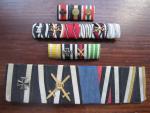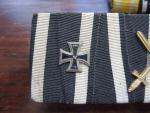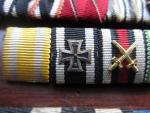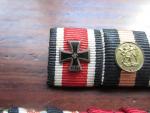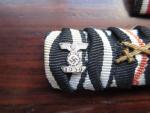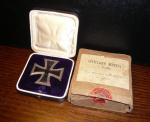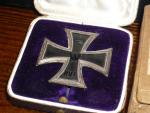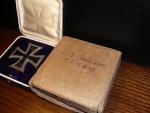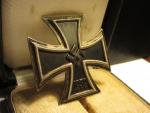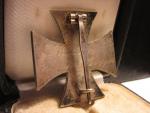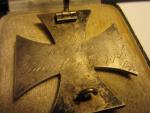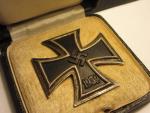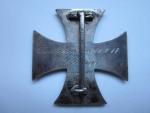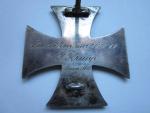-
Posts
555 -
Joined
-
Last visited
Content Type
Profiles
Forums
Blogs
Gallery
Events
Store
Everything posted by Brian R
-
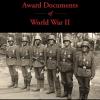
EK All Eras Iron Cross Minis - Three Wars Worth
Brian R replied to Brian R's topic in Germany: All Eras: The Iron Cross
Very cool, Chris. I'm not sure I've seen that embroidered type before. -

EK All Eras Iron Cross Minis - Three Wars Worth
Brian R replied to Brian R's topic in Germany: All Eras: The Iron Cross
Thanks, guys. Yes, I have seen the flower war minis before - and if I remembering correctly, I have seen them in period portraits as well. However, I've never seen the mini EK. Definitely unofficial. -
Here are a few interesting minis for your viewing pleasure, representing the FP War, WWI and WWII. Note the mini EK on the Saxon bar is upside down. It's really not the mini that is wrong, its the ribbon. I could switch it but the tabs on the reverse look like they have been that way for a long time. So, I leave it alone - I wonder of the original wearer noticed! Does anyone have any other 1939 examples to show? Note this one is quite unlike the earlier ones. These are quite unusual. I showed it to Rick L. way back in the day and he approved.
-

EK 1939 Iron Cross Award Documents Article
Brian R posted a topic in Germany: All Eras: The Iron Cross
Hi Guys - If you haven't seen it yet, check out the EK documents article in the latest issue if International Militaria Collector. In addition to this specific article, the magazine is worth the price given that each issue usually has at least one Iron Cross related write-up. http://bdpublish.com/ -

EK 1914 Bulgarian soldier with EK .....
Brian R replied to Chris Boonzaier's topic in Germany: All Eras: The Iron Cross
Great picture! -

EK 1914 New engraved WW1 EK1.
Brian R replied to CRBeery's topic in Germany: All Eras: The Iron Cross
I completely agree with Chris. There is no particular style to follow, and I don't necessarily agree with the "Imperial Standard". Not everyone had the same skill level back then. The way we judge these engraved crosses is based on our own comfort level. We have a checklist we follow as individuals to determine authenticity, but that checklist likely varies from collector to collector. There are a lot of nice items that are fake and simple engravings that are real, and patina can vary depending on a variety of factors. I still believe that a lot of good engravings get passed over, because they don't offer the collector the confidence and comfort level often needed. This is a "gut" area of collecting. -

EK 1914 New engraved WW1 EK1.
Brian R replied to CRBeery's topic in Germany: All Eras: The Iron Cross
I agree with all of the above. The skillset that existed years ago does not necessarily exist today. Yet, even if its not prevalent, there are folks who can still do it. Also, almost 100 years has passed - that's a lot of time for an original EK to get "enhanced". As I learned doing research for my book project, EVERYTHING has been faked. I was surprised to find the number of EK Vorschlagslisten out there that are bad. I would have never thought that these things would be faked to the extent that they have - it's simply amazing to see the write-ups that exist, rationale for the award of the EK, that are actually total BS - the soldier and the events are completely made up. There are V-lists out there with really convincing stamps, clerical "notes" and signatures that are just total garbage. I agree with you guys in that it's a "gut" thing - it's a matter of judging various aspects of an engraved cross, like a combination of content, patina, style, etc. Engraving is unique in that the rules that apply to most types of militaria as far as determining authenticity don't necessarily apply. It's such a unique market that - often times good pieces are passed over, just because we can't be sure. I think there a lot of good crosses out there that lose out (they don't offer a collector the comfort level needed) once they are separated from supporting documentation and/or provenance. -

EK 1914 New engraved WW1 EK1.
Brian R replied to CRBeery's topic in Germany: All Eras: The Iron Cross
I admit that my comments above are somewhat of a leap of faith, but I would expect some debate on this. Surely, some would disagree, no? -

EK 1939 Engraved 1939 Iron Cross First Class
Brian R replied to Brian R's topic in Germany: All Eras: The Iron Cross
Thanks, Glenn. I really like it and would love to find a couple more engraved 1939 EK1s for my collection. Someday... -

EK 1914 Displaying WW1 EK1s with the recipient...
Brian R replied to Chris Boonzaier's topic in Germany: All Eras: The Iron Cross
That picture on the right is priceless. Very nice display! -
I think the best way is to hit it from different angles with your camera - flash and no flash - and try it outside as well.
-

EK 1914 New engraved WW1 EK1.
Brian R replied to CRBeery's topic in Germany: All Eras: The Iron Cross
I would love to own this cross. Engraved crosses are so tricky. I have one that seems to lack any significant patina - one that makes me quite skeptical. However, the quality is excellent as is the name, rank and battle information. I showed it to a number of knowledgeable Imperial collectors at the MAX and they all agreed it was good, despite the limited patina. At this point, there are certain engraving styles I know to stay away from. But, I'm convinced that many or most of the engraved crosses we see (as long as what's actually engraved is plausible) are legit. As we've seen (and Chris has pointed out) thousands of Imperial EKs were likely engraved or personalized from the teens through the 40s. I often wonder how cost effective it is today to take the time to hand-engrave an EK to enhance its value. Is taking the time to do it really worth the couple hundred bucks it could "enhance" the value? -
I wonder if we are seeing more because they are so expensive - collectors may be cashing in? I have one too. I've had it for about 12 years or so. In this case, it is a cased Godet to Feldwebelleutnant Gebhard of Reserve Infantry Regiment 212. I have no specific information on him, but I know this unit was primarily from Prussian Pomerania. The unit fought exclusively on the Western Front throughout the war - Flanders, Somme, Argonne etc.
-

EK 1939 Reichsgezetzblatt For EK2 - Groesse Kz
Brian R replied to Jock Auld's topic in Germany: All Eras: The Iron Cross
:love: Very cool, Jock. If I remember correctly, the amendments would reference later editions through 1943. -

EK 1914 Beaten but named EK1
Brian R replied to Chris Boonzaier's topic in Germany: All Eras: The Iron Cross
Excellent points. Chris. Just thinking about the amount of crosses engraved during the post-1918 period relative to the post-1945 period speaks volumes. -

EK 1914 Der Stahlhelm letter - Iron Crosses
Brian R posted a topic in Germany: All Eras: The Iron Cross
Here is a rather interesting letter processed by Der Stahlhelm of Gau Mosel in September 1931 confirming that a certain Oskar Keyser was a recipient of both classes of the Iron Cross during the 1914-1918 period. -

EK 1939 Engraved 1939 Iron Cross First Class
Brian R posted a topic in Germany: All Eras: The Iron Cross
While studying engraved crosses from the First World War can be a challenge - and is often a matter of "comfort" - engraved crosses from World War II can be far more of a mystery. There seem to be very few "real" engraved crosses from the WWII era relative to the amount engraved and personalized by recipients and jewelers during and immediately after World War I. I have four attributed EK1s from the Third Reich era but only one is engraved - this one below to a Karl Heinz Gröpper. It is a nice, unmarked vaulted cross made by Klein & Quenzer and includes the date of September 13, 1942 and reference to a place called Bili Bor. I have no definitive information about the specifics of this cross but by best guess is that it is a reference to fighting Partisans in the Bor region of Serbia. It appears that 704. ID was the unit in the area at the time but there is no specific evidence, that I am aware of, that there were actions in this area on or shortly before this date. It is also possible that the engraving is actually in reference to Biely Bor in Belarus, but that remains a mystery as well. If it is, then this scenario is also related to fighting Partisans as the frontline of Army Group Center was much farther east at the time. Nevertheless, this is a neat cross. And the odd location name on the back adds to me comfort level that it is a period inscription as most fake engravings include famous battles, units or recipients. -

EK 1914 Beaten but named EK1
Brian R replied to Chris Boonzaier's topic in Germany: All Eras: The Iron Cross
True. Perhaps more private purchasing meant more opportunities to employ the services of a jeweler/engraver. I have one engraved WWII EK1 - I will post it in a new thread. -

EK All Eras Welcome Brian R...
Brian R replied to Chris Boonzaier's topic in Germany: All Eras: The Iron Cross
Thanks for the messages, guys. I have been reorganizing my office over the last few days and have added a new curio cabinet for displaying more stuff. As a result, I have a few odds and ends to post in the near future. -

EK 1914 Beaten but named EK1
Brian R replied to Chris Boonzaier's topic in Germany: All Eras: The Iron Cross
Great cross, Glenn. I really like crosses with personal inscriptions like yours. It's amazing to see how prevelant the engraving of EKs was in the WWI years relative to how uncommon it was during the Second World War. -

EK 1914 Nice 4th Reserve Jäger EK Doc
Brian R replied to Chris Boonzaier's topic in Germany: All Eras: The Iron Cross
The EK symbolism of the 1914-1918 period will never seize to amaze. Really interesting looking document! -

EK 1939 Iron Cross 2nd Class from the Sitzkrieg
Brian R replied to Brian R's topic in Germany: All Eras: The Iron Cross
I have scans of a Regimental Tagesbefehl from IR 181 that specifically mentions awards made/authorized by von Brauchitsch at OKH dated October 23, 1939. The awards were related to fighting on October 17th and 18th against French troops and the EK doc (belonging to one of the soldiers mentioned in the memo) was, indeed, signed by von Brauchitsch. So, yeah, I would imagine there was some great interest in the fighting and skirmishes in this neck of the woods by the highest authorities given the potential ramifications of a major fight with the French at the time. I would post the scans but they belong to another collector. -
Hi Chris - Yup, this one I feel very good about. In the world of engraved EKs, this one shows honest wear and consistent patina throughout. You can really see how well it all matches in the area where 239. Inf. Div. is carved out. I find that engraved crosses are especially hard to photograph given the various reflections, but this one is totally convincing in hand.
-

EK 1914 Displaying WW1 EK1s with the recipient...
Brian R replied to Chris Boonzaier's topic in Germany: All Eras: The Iron Cross
Awesome. There's not much better than attributed EKs.


